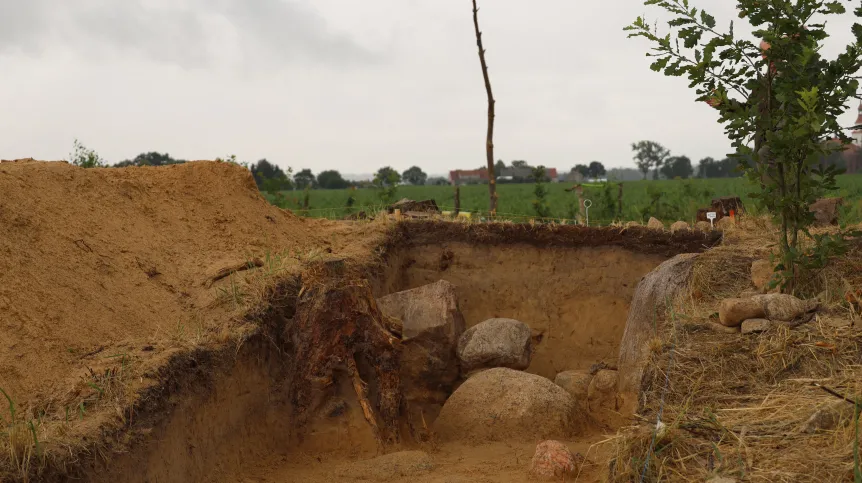Polish archaeologists have uncovered a remarkable set of ancient structures in the village of Wyskoć, located in the Wielkopolska region. These large, triangular earth mounds —nicknamed “Polish pyramids”— date back 5,500 years and contain megalithic tombs from one of the earliest agricultural communities in the area.
The discovery was made by archaeologists from Adam Mickiewicz University in Poznań during a field survey regularly conducted using remote sensing technology. The research was led by Dr Danuta Żurkiewicz and Dr Iwona Sobkowiak-Tabaka, Professor at the Adam Mickiewicz University.
The tombs, whose existence was confirmed through excavations, were constructed by the Funnelbeaker Culture, a Neolithic society characterized by pottery and monumental burials. The new findings are the second of their kind to be identified in the Wielkopolska region, the first being in 2019.
The megaliths in Wyskoć are elongated earth mounds up to 200 metres long, constructed in the form of an elongated triangle, whose front was several metres wide and about four metres high. The mound gradually narrows and lowers, passing into a so-called tail.
The most significant boulders, weighing up to several tonnes, were placed at the head of the megalith. The stones were laid vertically and stabilised or raised with smaller stones. The face of the megalith was oriented to the east and the tail to the west. It is presumed that this form of tomb was intended to relate in shape to the long trapezoidal houses built by earlier Neolithic cultures.
“During the excavations, the remains of a structure made of stone were uncovered. The elements of the stone enclosure of this structure were captured very nicely. They have pushed around because 5,500 years have affected the structure, however, the major boulders that formed the front of the megalith are no longer there. For thousands of years, people have needed stone, so they picked up these stones, split them, and as a result, the object has been heavily degraded,” Artur Golis, chief specialist in nature and landscape conservation from the Greater Poland Voivodeship Landscape Parks Complex, described to PAP.
Five ‘promising’ features were initially identified in the park. Two of them were found at the described site. One of these has been excavated so far, but researchers hope the remaining locations will provide more information about the social lives and spirituality of Neolithic Poland.
– Although the Funnel Cultures were relatively egalitarian communities, the tombs were used to bury people significant to the community – a leader, a priest, a shaman. Each generation of a community buried its megalith – as Golis explained.
Most of the monuments of this type have been found in the Kuyavian region in northwestern Poland, and therefore, the Wielkopolska discovery is exceptionally significant for regional history. These “Polish pyramids” are some of the largest prehistoric burial structures in Poland.
For now, the site remains closed to the public. Once archaeological work is complete, authorities will decide whether to make these prehistoric monuments accessible to visitors.

Photo source: The Landscape Parks Complex of the Greater Poland Voivodeship (ZPKWW)
Source:
Nauka w Polsce
Adam Mickiewicz University
notesfrompoland.com
archaeologymag.com


